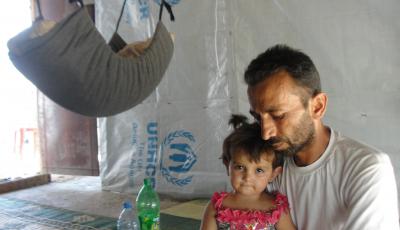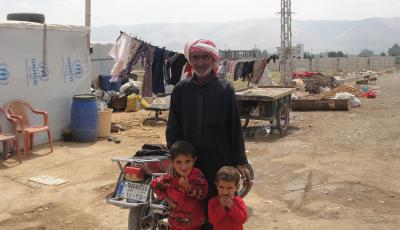Burden or Brothers? Media Representations of Refugees in the Middle East
Posted:
Time to read:
Guest post by Nouran El-Behairy, a journalist and researcher interested in media and refugee studies. She recently finished her joint MA degree in journalism from Hamburg University, Germany and Aarhus University, Denmark. Her thesis focused on humanitarian communication and media coverage of refugees in the Arab world. She holds a BA in mass communication from Cairo University, Egypt. Nouran volunteered to work with Syrian refugees in Lebanon’s Bekaa valley in 2014. Currently she’s helping with the settlement and integration of Syrian refugees arriving in Germany and hopes to work in communication for international organizations. Nouran is on Twitter @norabeh.
Much of the research analyzing media representations of refugees since WWII has come from western countries and focuses on incoming asylum seekers and refugees. There are three main themes that summarize the existing media discourses about refugees in western media, namely in Europe, North America, Australia, and New Zealand: ‘voiceless masses,’ ‘bogus opportunists,’ and ‘substantial threats to national security and identity.’ Notwithstanding the existence of some positive discourses, the media and research on the media tend to focus on negative portrayals of refugees as the ‘other,’ drawing the line between ‘us’ and ‘them.’

Scholars suggest that the Middle East or more specifically the Arab world has different rules when it comes to refugees. These countries have a shared history and religious and cultural ties. Above all they share the concept of Uruba (Arabic for Arab nationalism). Together, these approaches provide a sense of ‘brotherhood’―here used in its gendered form in an attempt to be culturally specific as per the conventional notion of Arab brotherhood―which governs how refugees are welcomed and treated, and it may be presumed that this would be reflected in local media representations as well.
However, an analysis of the coverage of the Syrian refugees in Lebanon has yielded rather different findings. In this blog post, I present the results of an analysis of the Lebanese media coverage of Syrian refugees and compare it to research findings on the typical representation of refugees in western media.
The Case Study: Syrians in Lebanon
Owing to the open border policy with Syria, more than one million Syrian refugees crossed into Lebanon since 2011, and these numbers reflect only those officially registered with UNHCR. Added to half a million Palestinian refugees already settled in Lebanon, this small Mediterranean country held the highest concentration of refugees per capita in the world in 2014.
A content analysis of the coverage of Syrian refugees in the two biggest Lebanese newspapers, An-Nahar and As-Safir, reveals many similarities to how this group is represented in western countries. Refugees were routinely referred to as a threat and a burden in Lebanese media. At the same time, they were left voiceless as journalists rarely interviewed them, opting instead to depict them as masses, as statistics, and in terms of costs.
Three main themes sum up the representation of Syrian refugees in Lebanon. First, the idea that ‘Lebanon cannot be alone’ highlights the burden that these refugees represent to Lebanon in general and to its economy in particular. Refugees are seen to be stealing jobs, increasing government spending, and pushing Lebanese people into poverty in an already strained and fragile infrastructure. Lebanon is presented as needing assistance through calls on the international community to share the burden, by offering funds or hosting some of the refugees. Within this theme, criticism is levelled towards the international community for its unresponsive attitude to the situation.
The second theme to emerge suggests that ‘refugees would cause the collapse of Lebanon.’ Here, Syrian refugees are represented as a ‘time bomb’ and a menace to Lebanese security through narratives of terrorist threat. They are also seen to bring the re-ignition of a civil war because their story is portrayed as a larger scale repetition of the Palestinian refugee crisis in Lebanon. More importantly, they are seen to be tilting the demographic and confessional balance in the country, where the political situation is highly reliant on sectarianism.
‘Bogus partners in misery’ is the final theme, according to which both Lebanese and Syrians live in miserable conditions, whereas only the latter benefit from aid offered by international organizations. Although Lebanon isn’t a welfare state, refugees were still described as ‘bogus.’ The media commonly claim that Syrians are coming from safe areas inside Syria into Lebanon to benefit from the aid efforts of international organizations. Syrians are therefore accused of straining the economy and depleting resources, just as in western media like in Britain, Australia, Canada, and Eastern Europe. Even a few kilometres from their borders, Syrian refugees were still treated in the media as ‘the other.’ Arab nationalism and shared history didn’t change the outcome of the media representations.
Same Techniques, Different Motives

Many academic studies attribute negative coverage of minorities in the media to political influence, arguing that political interests often encourage the escalation of fear of refugees in efforts to consolidate positions prior to elections and expand policies that similarly serve their interests (see here and here for instance). My analysis of media coverage in Lebanon also suggests that different media outlets with partisan allegiances use particular discourses around refugees in their political conflicts. Another political motive for this type of coverage is what Chit and Nayel refer to as ‘diversion.’ They suggest that the scapegoating of refugees by both Lebanese media and political elites work to remove, or at least, minimise the government’s responsibility for the problems currently afflicting its population.
Lebanon also allocates blame to the international community. Lebanon is not a signatory state to the Geneva 1951 Convention on refugees, which in practical terms means that the country has only a limited obligation towards refugees, whose responsibility should thus lay at the hands of the international community. Or so it’s argued by the national political elite and the media. This is a stance usually adopted by developing countries. For instance, Crisp has noted an implicit deal between developed and developing countries in which the latter should host refugees while the former provide financial and logistical aids. However, when media attention shifts from the developing host country, fears are raised that financial support many decline, leaving the host to deal with the crisis alone. Coverage of refugees in Lebanon thus uses a mix of sympathy and fear in an attempt to attract back that attention and subsequently ensure that international aid keeps coming in.
What Should We Do About It?
Most members of the public rarely have the opportunity to interact directly with refugees, most of whom live in camps outside cities. Under these circumstances, the media have an important role to play in informing the public. If refugees continue to be ‘othered’ through media representations in the ways described above, the consequences are likely to be grave as tensions can escalate amidst misinformation and fears about scarce resources. Media messages clearly need to be re-examined. In the context of a prolonged refugee movement and displacement, durable solutions are needed for more balanced, accurate, and representative information to be portrayed by the media.
For media professionals the answer is simple: context. The International Centre about Asylum and Refugees (ICAR) provides a set of rules for reporting on refugees that include providing background information, being informative, including different voices, and avoiding generalizations that may lead to incitement.
For readers the answer is: awareness. Readers should be aware of political agendas and of the situations of refugees, while staying informed and paying attention to the normalization of labels and discourses in media representations of refugees.
Any comments about this post? Get in touch with us! Send us an email, or post a comment here or on Facebook. You can also tweet us.
__________
How to cite this blog post (Harvard style):
El-Behairy, N. (2016) Burden or Brothers? Media Representations of Refugees in the Middle East. Available at: https://www.law.ox.ac.uk/research-subject-groups/centre-criminology/centreborder-criminologies/blog/2016/05/burden-or (Accessed [date]).
Share:








